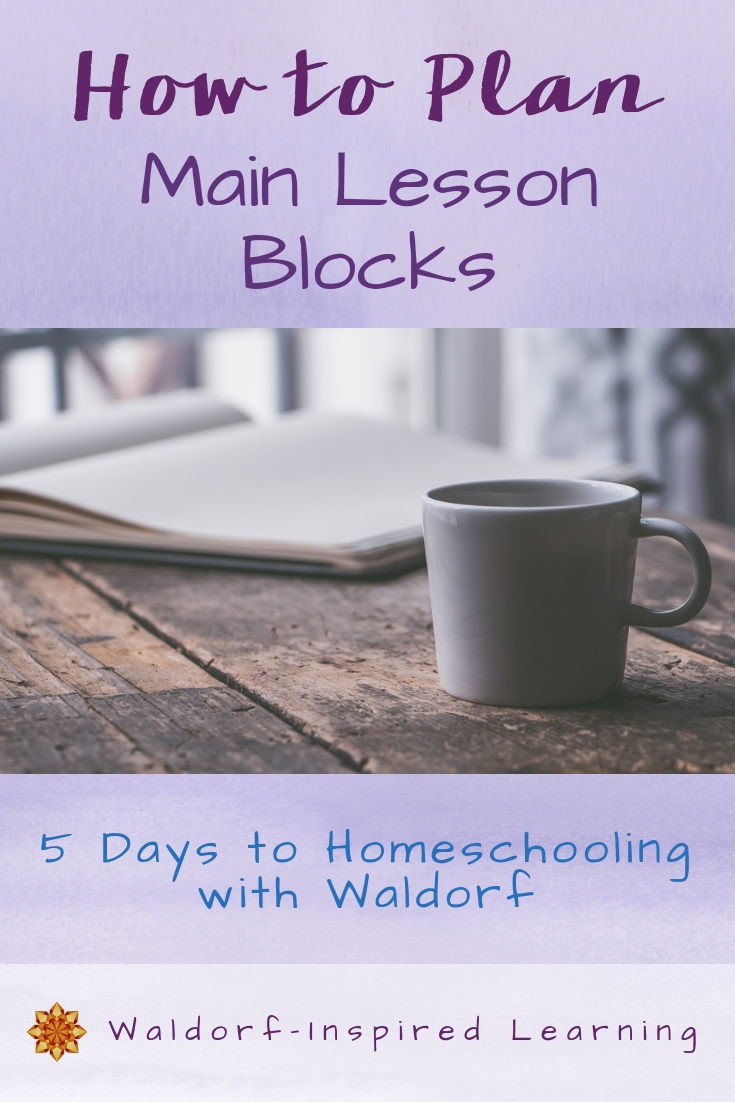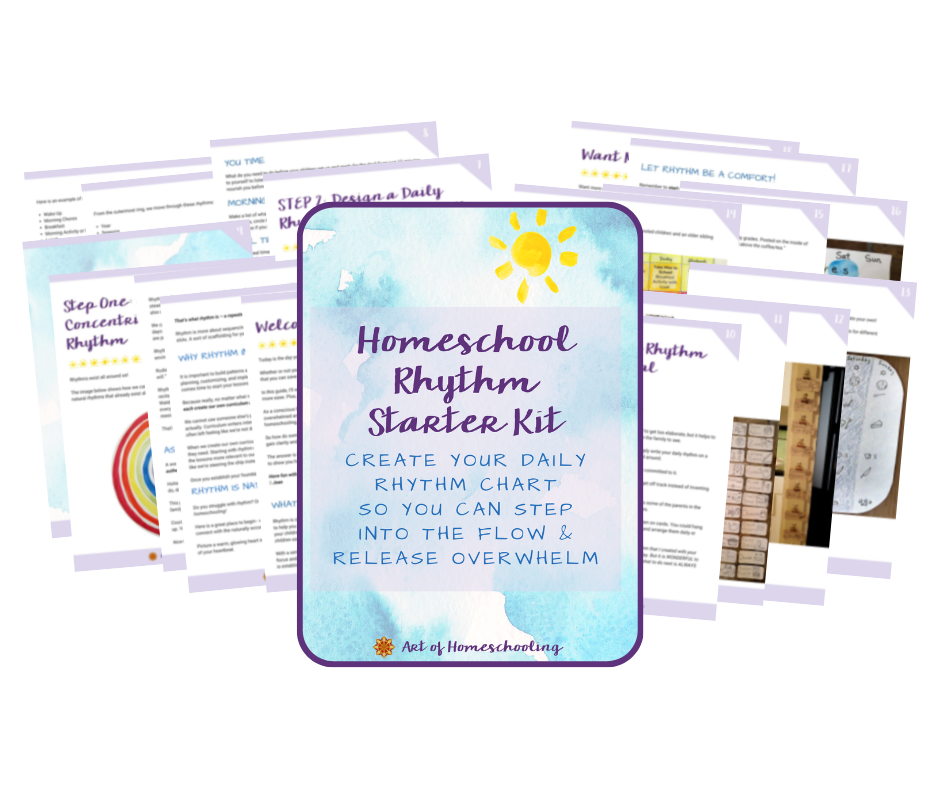Last August, at the annual Taproot Teacher Training, my friend Alison and I led off our workshop for grades 3 & 4 by saying: “you can plan a main lesson block around a single book.” Our homeschooling Moms said this was their biggest takeaway. A huge “aha” moment. The most important lesson here in how to plan a main lesson block is to keep it simple.
I like to say “start small and add from there.”

Where to Start with Planning a Main Lesson Block
I mentioned the starting point in yesterday’s post, The Essential Elements of a Main Lesson Block. Start your planning by fleshing out these three activities.
- Circle Time (or Warm-Up Time)
- Story
- Artistic Activity
How to Plan a Main Lesson Block
There are so many ways to keep track of plans. PICK ONE that works for you. You might write your plans by hand in a traditional teacher planner. Perhaps it’s simply on a calendar, or you prefer to plan digitally. You could create a planning form in Microsoft Word or as an Excel sheet. These days, I really like using a Bullet Journal for planning.
Whatever system you want to use, simply choose and stay consistent for a period of three to six months so that you can see if it’s working well or what you might need to tweak. My experience with homeschoolers is that we change things up way too often, thinking the new system, or curriculum, or style will solve all of our problems.
When in fact, the answer is often to simplify and stay focused. Keep showing up.
Here is a simple version of a planning form that you might consider creating for yourself:
| Day of Week/Activity | Verses & Songs | Story | Artistic Activity |
| Monday | |||
| Tuesday | |||
| Wednesday | |||
| Thursday |
For years, I would print out a basic form like this for each week. And keep them in a project folder. That was my Homeschooling Planner. So very simple. But it worked.
This reminds me of some wonderful advice I’ve gleaned over the years: “only make your plan as complicated as it needs to be.” If super simple works, stick with it!
After deciding on your form or where you will list your activities for each day of your main lesson block, the next step is to fill in the form. Keep it short and sweet by just listing the three or five or seven songs and verses you’ll do this week. The story you plan to share. And the painting or drawing or other artistic activity you plan to do. Just a note that will remind you of what you have in mind.
It’s the Doing That Counts
And remember, it’s the doing that counts. It’s not the thinking about, or searching, or revising our plans that matters. It’s how we show up with our children and actually happens that really counts.
This is not easy for many of us. We sometimes make the mistake of believing that a detailed, airtight plan will guard against unwanted behavior. Or boredom. Or distraction.
When in fact, the goal is to make the plan but then be present enough to guide that plan while being flexible enough to go with the interests and energy in the children before us.
The more detailed the plan is, the more attached we often become to it going a certain way. Which also usually means the more frustrated we become when things don’t go as planned!
If you want more support to help you make this magic planning process unfold, I recommend my primer, Homeschool Simplicity 101.
And if you’re looking for ongoing support, come join an amazing group of Waldorf homeschoolers inside my mentorship community, Inspired at Home. Where you get the training and help you need to sustain your homeschooling journey.
This post is part of a series, 5 Days to Homeschooling with Main Lesson Blocks. Tomorrow, I will delve into how to help your children create their very own main lesson book as a record of their learning, Day 5: Recording the Learning in a Main Lesson Book.
5 Days to Homeschooling with Main Lesson Blocks
Hop around to all the posts in this series to find all you need to homeschool with main lesson blocks!
Day 1: What is a Main Lesson Block?
Day 2: Why Does Main Lesson Block Learning Work?
Day 3: The Essential Elements of a Main Lesson Block
Day 4: How to Plan Main a Lesson Block (That’s this post!)
Day 5: Recording the Learning in a Main Lesson Book



Hi Jean!
I’m really enjoying this series, I’ve been reading about Waldorf education for about a year in preparation for homeschooling my children and haven’t found anywhere else that really explained the Main Lesson concept thoroughly. I have a question about the Taproot Teacher Training; is it mostly for parents whose children are ready for real academic work, or can parents of kindergarten-age children benefit as well?
Great question, Amber. Kindergarten is one of the workshops offered, and yes those with young children can benefit from coming to Taproot! While the majority of participants have children in the grades, every year we have a few with just kindergarten-age children. Taproot could help you prepare for kindy, give you a sense of what’s to come, and an opportunity to meet other Waldorf homeschoolers on this journey. 🙂
Hi Jean, I’m wondering a bit more about what Day 2 looks like. If you do the new story on day 1, what does the “story” portion look like on day 2? Is it just a verbal retelling with help from the child? Then straight to the table to write it down? Is there a new story on day 2 at the end of the lesson? For example, in the 4 day week example, are we only working through 2 stories total or 3-4?
Also curious if you have any posts on how to teach multiple ages. For couch time, do you read one book for each child or can the younger one listen in on Saints stories of the grade 2 child? If the concepts are so developmentally appropriate, is it ok for everyone to listen in on everyone else’s material? How does this work in a homeschool setting? And my last question is when doing couch time, is it better to only read the story for the day’s lesson or can it be treated as readaloud time with several different books?
I love your content!!
Sorry for my many questions 😊
Wow, great questions Belinda! Yes Day 2 is usually a collaborative retelling. Some parents and teachers bring another story at the end of Day 2, but you don’t have to. You’ll find the rhythm that works best for you. And for sure, all kids can listen in on the stories. You can even build lessons around one book for all ages.
I have a few podcast episodes and a resource to recommend that can help:
EP #120: How to Make Waldorf More Homeschool Friendly https://artofhomeschooling.com/episode120/
EP #29: Holistic Homeschooling: A Day in the Life https://artofhomeschooling.com/episode29/
Book Study Guide: https://artofhomeschooling.com/i-am-coyote-free-book-study-guide/